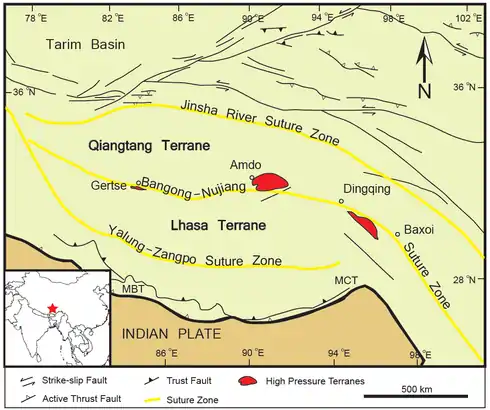Qiangtang terrane
The Qiantang terrane is one of three main west-east-trending terranes of the Tibetan Plateau.


During the Triassic, a southward-directed subduction along its northern margin resulted in the Jin-Shajing suture, the limit between it and the Songpan-Ganzi terrane. During the Jurassic, the Lhasa terrane merged with its southern margin along the Bangong suture.[1] This suture, the closure of part of the Tethys Ocean, transformed the Qiantang terrane into a large-scale anticline.[2]
The Qiantang terrane is now located at c. 5,000 m (16,000 ft) above sea level, but the timing of this uplift remains debated, with estimates ranging from the Pliocene-Pleistocene (3–5 Mya) to the Eocene (35 Mya) when the plateau was first denudated.[3]
See also
Qiangtang terrane related (from south to north)
- Transhimalaya, includes following:
- High pressure metamorphic terranes along the Bangong-Nujiang Suture Zone
- Qiangtang terrane
References
Notes
- Wang et al. 2008, Geologic setting, p. 475
- Xu et al. 2013, Geologic setting, pp. 32–33
- Xu et al. 2013, Introduction, pp. 31–32
Sources
- Wang, Q.; Wyman, D. A.; Xu, J.; Wan, Y.; Li, C.; Zi, F.; Jiang, Z.; Qiu, H.; Chu, Z.; Zhao, Z.; Dong, Y. (2008). "Triassic Nb-enriched basalts, magnesian andesites, and adakites of the Qiangtang terrane (Central Tibet): evidence for metasomatism by slab-derived melts in the mantle wedge". Contributions to Mineralogy and Petrology. 155 (4): 473–490. doi:10.1007/s00410-007-0253-1. S2CID 140614302. Retrieved 1 January 2020.CS1 maint: ref=harv (link)
- Xu, Q.; Ding, L.; Zhang, L.; Cai, F.; Lai, Q.; Yang, D.; Liu-Zeng, J. (2013). "Paleogene high elevations in the Qiangtang Terrane, central Tibetan Plateau" (PDF). Earth and Planetary Science Letters. 362: 31–42. doi:10.1016/j.epsl.2012.11.058. Retrieved 1 January 2020.CS1 maint: ref=harv (link)